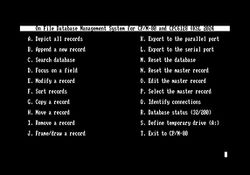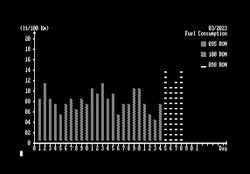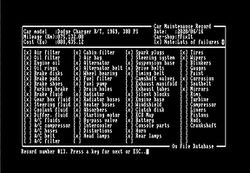Difference between revisions of "On File"
(Created page with "On File Database Management System will be released in summer 2024 in order to celebrate the anniversaries of CPC (40 years!) and CP/M-80 (50 years!).") |
(Category) |
||
| (23 intermediate revisions by 2 users not shown) | |||
| Line 1: | Line 1: | ||
| − | On File Database Management System | + | [[Image:On_File_Main_Menu.jpg|right|thumb|250px|On File main menu]] |
| + | [[Image:On_File_typical_record.jpg|right|thumb|250px|On File fuel consumption record]] | ||
| + | [[Image:On_File_Car_Maintenance_Record.jpg|right|thumb|250px|On File car maintenance record]] | ||
| + | |||
| + | |||
| + | '''On File''' Database Management System was released in June 2024 by [[KSL]] in order to celebrate the anniversaries of CPC (40 years!) and CP/M-80 (50 years!). On File is a business application similar to the MSDOS-era PC applications and one of the most recent (2024) projects developed for CP/M. On File database is disk-based, quick and reliable. It uses the entire CPC screen as the platform for the records; thus there is plenty of space to store large amount of data. In addition, a wide variety of characters and symbols can be included in the records, hence the database can contain data beyond the typical and traditional text type. Setting up a new database using On File is very easy and can be performed in three steps: 1) start the new file system by resetting the database and the master record, 2) frame/draw and edit the structure of the master record, 3) append new records in the database. The database is fully dynamic, thus the user can modify the master record as well as any record anytime. Furthermore, the database can be either flat or relational. Children records include the ^ symbol followed by the relational key and one space, for example ^Z80 . Parent records include the relational key (not the ^ symbol) followed by one space, for example Z80 . Every record has its own unique filename, stored in the disk drive. On File capacity is 200 records (equal to 400 KB), it is thus an ideal application for the 20 MB [[Dobbertin Harddisc]] which supports up to 512 file entries as well as [[ROMDOS]] or [[ParaDOS]] disks (128 x 2). Furthermore, On File can be also executed entirely from the RAM Disk. <br> | ||
| + | |||
| + | As per [[Cosmos]], On File has been developed on the basis of the hardware peripherals as well as the software that were (contemporary) available for the CP/M and the CPC6128: the 512 KB [[Dobbertin Memory Expansion]], the [[ParaDOS]] or [[X-DDOS]] ROMS for the external (800 KB) floppy drive, the 20 MB [[Dobbertin Harddisc]], the [[Amstrad Serial Interface]], the Amstrad Parallel [[Printer Port]], the [[CTM640/CTM644]] colour monitor, the [[AMX Mouse]], the [[MicroScript]] (142 KB), the [[WordStar]] (706 KB), the [[Protext]] (406 KB), the [[Multiplan]] (208 KB), the [[SuperCalc 2]] (240 KB), the [[dBase II]] (272 KB), the [[DR Draw]] (235 KB), the [[DR Graph]] (306 KB), the [[MAXAM]] (206 KB), the [[Atlast Plus]] (224 KB) and other [[Programming software]]. On File includes a graphics screen saver, is based on the [[Dobbertin]] version of CP/M 2.2 (v1.2) which provides 59 KB TPA, supports the RAM expansion and the 20 MB hard disk. The original disk contains some demo master records (*.002 files), some demo records as well as the boot sectors for CP/M 2.2 (v1.2) | ||
| + | |||
| + | == Download == | ||
| + | * [http://www.cpcwiki.eu/index.php/File:On_File_2024_Boot_Disk.dsk Download from CPCWiki] | ||
| + | |||
| + | [[Category:Applications]] [[Category:CP/M]] | ||
Latest revision as of 16:26, 11 June 2024
On File Database Management System was released in June 2024 by KSL in order to celebrate the anniversaries of CPC (40 years!) and CP/M-80 (50 years!). On File is a business application similar to the MSDOS-era PC applications and one of the most recent (2024) projects developed for CP/M. On File database is disk-based, quick and reliable. It uses the entire CPC screen as the platform for the records; thus there is plenty of space to store large amount of data. In addition, a wide variety of characters and symbols can be included in the records, hence the database can contain data beyond the typical and traditional text type. Setting up a new database using On File is very easy and can be performed in three steps: 1) start the new file system by resetting the database and the master record, 2) frame/draw and edit the structure of the master record, 3) append new records in the database. The database is fully dynamic, thus the user can modify the master record as well as any record anytime. Furthermore, the database can be either flat or relational. Children records include the ^ symbol followed by the relational key and one space, for example ^Z80 . Parent records include the relational key (not the ^ symbol) followed by one space, for example Z80 . Every record has its own unique filename, stored in the disk drive. On File capacity is 200 records (equal to 400 KB), it is thus an ideal application for the 20 MB Dobbertin Harddisc which supports up to 512 file entries as well as ROMDOS or ParaDOS disks (128 x 2). Furthermore, On File can be also executed entirely from the RAM Disk.
As per Cosmos, On File has been developed on the basis of the hardware peripherals as well as the software that were (contemporary) available for the CP/M and the CPC6128: the 512 KB Dobbertin Memory Expansion, the ParaDOS or X-DDOS ROMS for the external (800 KB) floppy drive, the 20 MB Dobbertin Harddisc, the Amstrad Serial Interface, the Amstrad Parallel Printer Port, the CTM640/CTM644 colour monitor, the AMX Mouse, the MicroScript (142 KB), the WordStar (706 KB), the Protext (406 KB), the Multiplan (208 KB), the SuperCalc 2 (240 KB), the dBase II (272 KB), the DR Draw (235 KB), the DR Graph (306 KB), the MAXAM (206 KB), the Atlast Plus (224 KB) and other Programming software. On File includes a graphics screen saver, is based on the Dobbertin version of CP/M 2.2 (v1.2) which provides 59 KB TPA, supports the RAM expansion and the 20 MB hard disk. The original disk contains some demo master records (*.002 files), some demo records as well as the boot sectors for CP/M 2.2 (v1.2)


